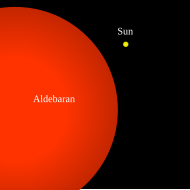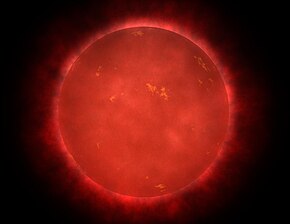IntroductionA star is a luminous spheroid of plasma held together by self-gravity. The nearest star to Earth is the Sun. Many other stars are visible to the naked eye at night; their immense distances from Earth make them appear as fixed points of light. The most prominent stars have been categorised into constellations and asterisms, and many of the brightest stars have proper names. Astronomers have assembled star catalogues that identify the known stars and provide standardized stellar designations. The observable universe contains an estimated 1022 to 1024 stars. Only about 4,000 of these stars are visible to the naked eye—all within the Milky Way galaxy. A star's life begins with the gravitational collapse of a gaseous nebula of material largely comprising hydrogen, helium, and trace heavier elements. Its total mass mainly determines its evolution and eventual fate. A star shines for most of its active life due to the thermonuclear fusion of hydrogen into helium in its core. This process releases energy that traverses the star's interior and radiates into outer space. At the end of a star's lifetime as a fusor, its core becomes a stellar remnant: a white dwarf, a neutron star, or—if it is sufficiently massive—a black hole. Stellar nucleosynthesis in stars or their remnants creates almost all naturally occurring chemical elements heavier than lithium. Stellar mass loss or supernova explosions return chemically enriched material to the interstellar medium. These elements are then recycled into new stars. Astronomers can determine stellar properties—including mass, age, metallicity (chemical composition), variability, distance, and motion through space—by carrying out observations of a star's apparent brightness, spectrum, and changes in its position in the sky over time. Stars can form orbital systems with other astronomical objects, as in planetary systems and star systems with two or more stars. When two such stars orbit closely, their gravitational interaction can significantly impact their evolution. Stars can form part of a much larger gravitationally bound structure, such as a star cluster or a galaxy. (Full article...) Selected star - Photo credit: commons:user:Riffsyphon1024 and commons:user:Mysid
Aldebaran (α Tau, α Tauri, Alpha Tauri) is a red giant star located about 65 light years away in the zodiac constellation of Taurus. With an average apparent magnitude of 0.87 it is the brightest star in the constellation and is one of the brightest stars in the nighttime sky. The name Aldebaran is Arabic (الدبران al-dabarān) and translates literally as "the follower", presumably because this bright star appears to follow the Pleiades, or "Seven Sisters" star cluster in the night sky. In 1997 a substellar companion was reported but subsequent observations have not confirmed this claim. Aldebaran is classified as a type K5III star. It is an orange giant star that has moved off the main sequence line of the Hertzsprung–Russell diagram. It has exhausted the hydrogen fuel in its core and hydrogen fusion has ceased there. Although not yet hot enough for fusing helium, the core temperature of the star has greatly increased due to gravitational pressure and the star has expanded to a diameter of 44.2 times the diameter of the Sun,Richichi & Roccatagliata (2005) derived an angular diameter of 20.58±0.03 milliarcsec, which given a distance of 65 light years yields a diameter of 61 million km.</ref> approximately 61 million kilometres (see 10 gigametres for similar sizes). The Hipparcos satellite has measured it as 65.1 light-years (20.0 pc) away, and it shines with 150 times the Sun's luminosity. Aldebaran is a slightly variable star, of the slow irregular variable type LB. It varies by about 0.2 in apparent magnitude. Selected article - Photo credit: user:Pascalou petit
A stellar magnetic field is a magnetic field generated by the motion of conductive plasma inside a star. This motion is created through convection, which is a form of energy transport involving the physical movement of material. A localized magnetic field exerts a force on the plasma, effectively increasing the pressure without a comparable gain in density. As a result the magnetized region rises relative to the remainder of the plasma, until it reaches the star's photosphere. This creates starspots on the surface, and the related phenomenon of coronal loops. The magnetic field of a star can be measured by means of the Zeeman effect. Normally the atoms in a star's atmosphere will absorb certain frequencies of energy in the electromagnetic spectrum, producing characteristic dark absorption lines in the spectrum. When the atoms are within a magnetic field, however, these lines become split into multiple, closely spaced lines. The energy also becomes polarized with an orientation that depends on orientation of the magnetic field. Thus the strength and direction of the star's magnetic field can be determined by examination of the Zeeman effect lines. A star with a magnetic field will generate a magnetosphere that extends outward into the surrounding space. Field lines from this field originate at one magnetic pole on the star then end at the other pole, forming a closed loop. The magnetosphere contains charged particles that are trapped from the stellar wind, which then move along these field lines. As the star rotates, the magnetosphere rotates with it, dragging along the charged particles. Selected image - Photo credit: NASA/Walt Feimer
According to the Hertzsprung-Russell diagram, a red dwarf is a small and relatively cool star, of the main sequence, either late K or M spectral type. They constitute the vast majority of stars and have a mass of less than half that of the Sun (down to about 0.075 solar masses, which are brown dwarfs) and a surface temperature of less than 4,000 K. Did you know?
SubcategoriesTo display all subcategories click on the ►
Selected biography - Photo credit: Eduard Ender
Tycho Brahe, born Tyge Ottesen Brahe (de Knudstrup) (14 December 1546 – 24 October 1601), was a Danish nobleman known for his accurate and comprehensive astronomical and planetary observations. Coming from Scania, then part of Denmark, now part of modern-day Sweden, Tycho was well known in his lifetime as an astronomer and alchemist. His Danish name "Tyge Ottesen Brahe" is pronounced in Modern Standard Danish as [ˈtsʰyːə ˈʌtəsn̩ ˈpʁɑːə]. He adopted the Latinized name "Tycho Brahe" (usually /ˈtaɪkoʊ ˈbrɑː/ or /ˈbrɑːhiː/ in English) from Tycho (sometimes written Tÿcho) at around age fifteen, and he is now generally referred to as "Tycho", as was common in Scandinavia in his time, rather than by his surname "Brahe". (The incorrect form of his name, Tycho de Brahe, appeared only much later. Tycho Brahe was granted an estate on the island of Hven and the funding to build the Uraniborg, an early research institute, where he built large astronomical instruments and took many careful measurements. After disagreements with the new king in 1597, he was invited by the Bohemian king and Holy Roman emperor Rudolph II to Prague, where he became the official imperial astronomer. He built the new observatory at Benátky nad Jizerou. Here, from 1600 until his death in 1601, he was assisted by Johannes Kepler. Kepler later used Tycho's astronomical information to develop his own theories of astronomy.
TopicsThings to do
Related portalsAssociated WikimediaThe following Wikimedia Foundation sister projects provide more on this subject:
Discover Wikipedia using portals |
























